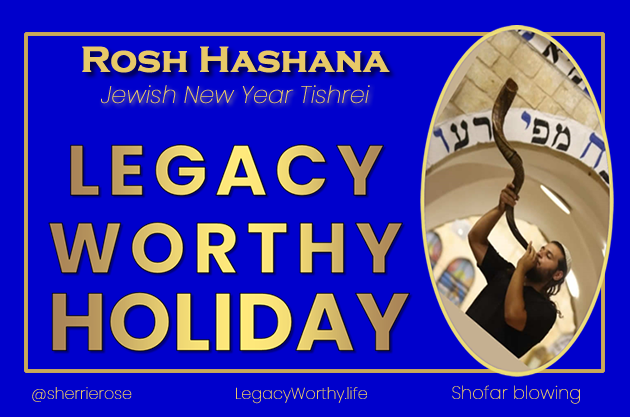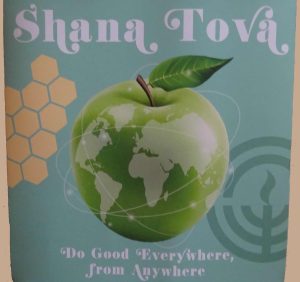The Jewish High Holidays – Rosh Hashanah to Yom Kippur

The Jewish High Holidays – Rosh Hashanah to Yom Kippur
The Jewish High Holidays from Rosh Hashanah to Yom Kippur, is an important season and part of Jewish culture and heritage for Jews around the world. During this period of reflection and atonement, Jews come together in prayer and celebration. Here we will explore the significance of the Jewish High Holidays, from Rosh Hashanah to Yom Kippur.
Rosh Hashanah, the new year, marks the beginning of the High Holidays as it is celebrated on the first day of Tishrei on the Hebrew calendar, which is typically in September or October on the Gregorian calendar. Special foods such as apples dipped in honey are eaten to symbolize a sweet start to the year ahead. The liturgy of this day centers around themes of repentance and forgiveness as Jews prepare for their spiritual journey into the New Year.
Yom Kippur follows ten days after Rosh Hashanah and is considered one of the most solemn days on the Jewish calendar. This day is dedicated to sincere repentance and reconciliation with God. Fasting is observed from sundown to sundown as an act of humility and devotion before God. At sundown, a special service known as Neilah marks the end of Yom Kippur with prayer for forgiveness just before sunset.
The Jewish High Holidays are considered a legacy-worthy holiday for several compelling reasons. Firstly, their origins trace back thousands of years to ancient Jewish traditions and rituals, showcasing a remarkable continuity of customs and beliefs throughout generations. This enduring connection to the past highlights their significance and are mentioned in the Bible.
Secondly, these Jewish holidays encapsulate fundamental themes of self-reflection, repentance, and forgiveness, which resonate deeply with individuals and communities. They provide an opportunity for spiritual growth and moral introspection, promoting values of compassion and empathy.
Thirdly, the Jewish High Holidays serve as a unifying force for Jewish communities around the world. They bring people together in prayer, celebration, and communal gatherings, fostering a sense of belonging and solidarity among Jews regardless of their geographical location.
Finally, the profound symbolism and rituals associated with Rosh Hashanah and Yom Kippur, such as the sounding of the shofar (ram’s horn) and the casting away of sins, serve as powerful reminders of the shared cultural and religious heritage. This enduring connection to history, deep-rooted values, and the sense of unity they promote make the Jewish High Holidays a holiday of great legacy and significance.
#1 Overview of The Jewish High Holidays
The Jewish High Holidays, or Yamim Nora’im, is a ten-day period beginning with Rosh Hashanah and ending with Yom Kippur. This is the holiest time of year for Jews, during which they reflect on their past actions and make resolutions for the future. Rosh Hashanah marks the start of a new year in the Hebrew calendar and is celebrated with meaningful meals, prayer services, and special dishes such as apples dipped in honey. Ten days later, Yom Kippur takes place and is known as the Day of Atonement. During this day, Jews engage in intensive fasting and prayer to atone for their sins from the previous year. In between these two holidays are several other important days including Tzom Gedalia and Erev Yom Kippur.
During the High Holidays it’s customary to attend synagogue services where people listen to stirring sermons and sing traditional melodies. The focus of these services is repentance and returning to God’s path through confession of wrongdoings, charity work, self-reflection, prayerful meditation, or studying religious texts. Additionally, many people visit gravesites of relatives during this time to honor their memory and say prayers on their behalf.
This period of sacred time culminates with Yom Kippur when families gather together for a final meal before sundown when fasting begins until nightfall when services conclude after 25 hours without food or drink. Afterward there’s a feeling of joyfulness that permeates throughout the community as everyone looks forward to another year filled with blessings from God.
#2 Meaning & Significance of The Jewish High Holidays
The High Holidays of Rosh Hashanah and Yom Kippur have deep meaning and significance within the Jewish faith. Celebrated together, these holidays signify a period of repentance, prayer, and self-reflection.
Rosh Hashanah marks the start of the Jewish New Year while also celebrating the birthday of mankind. During this two-day celebration, Jews typically attend synagogue services, reflecting on their lives and seeking forgiveness for last year’s mistakes. It is a time to reflect on how one’s life has developed since last year’s Rosh Hashanah.
Yom Kippur is often referred to as the holiest day in Judaism and is marked by fasting, prayer and repentance. This day focuses on achieving atonement with God through sincere repentance and heartfelt prayers for forgiveness. It serves as an opportunity to renew relationships with family and friends by asking for forgiveness from those we may have wronged throughout the past year.
On both Rosh Hashanah and Yom Kippur, Jews come together to celebrate their faith in a meaningful way that demonstrates their commitment to personal growth, spiritual renewal and community unity. These holidays remind us that no matter what happens during the course of a year, there is always an opportunity for reflection and renewal – which is why they remain so important in Judaism today.
#3 History & Practices of The Jewish High Holidays
Rosh Hashanah and Yom Kippur, the two most important holidays in the Jewish calendar, are known as the High Holidays. The two holidays are celebrated in the fall of each year and mark the start of a new year on the Jewish calendar’s civil cycle. Rosh Hashanah is a two-day observance that begins on Tishri 1 (the first day of Tishri), while Yom Kippur is observed on Tishri 10 (the tenth day of Tishri).
The High Holidays have been celebrated for centuries and their observances have evolved over time. On Rosh Hashanah, Jews gather to pray and to reflect on their lives over the past year. Traditional activities include eating apples dipped in honey to symbolize a sweet start to the New Year, blowing a shofar (a ram’s horn) during prayer services, and giving gifts of money or food to those in need. Yom Kippur is often referred to as “the Day of Atonement” because it is devoted to repentance and prayer for forgiveness from God. During this holiday, Jews fast for 25 hours and spend much of the day in synagogue praying and reflecting on their sins from the past year.
In Jewish tradition, Rosh Hashanah marks both a beginning and an end – it marks the beginning of a new civil year while also signifying that another year has passed. It is believed that God judges every person on earth during this time period; thus, it serves as an opportunity for Jews to consider how they can improve themselves before judgment day arrives. Similarly, Yom Kippur is seen as a chance for atonement; by fasting and spending time in prayer, Jews hope to be forgiven for sins committed during the previous year so that they may start anew with a clean slate.
Both of these holidays emphasize reflection and spiritual renewal: important aspects of life that can be beneficial all throughout the year. As such, many people use them as an opportunity not only to celebrate but also to contemplate life’s deeper questions – including what it means to live ethically within one’s community – so that they may strive towards personal growth with each passing cycle of time.
#4 Rosh Hashanah Traditions
Rosh Hashanah is a Jewish holiday that marks the start of the Jewish New Year. It is celebrated by attending synagogue services, eating symbolic foods and exchanging wishes for a sweet and prosperous new year.
One of the most important traditions of Rosh Hashanah is eating a round challah bread, which symbolizes the cycle of life. Challah is traditionally served with honey, which symbolizes hopes for a sweet and abundant new year. Other foods often eaten on Rosh Hashanah are apples dipped in honey, pomegranates, dates, leeks and carrots. Each food has its own special significance for the holiday.
The sound of the shofar (a ram’s horn) is an essential part of Rosh Hashanah celebrations. The shofar serves as a call to repentance and reminds us to reflect on our actions from the past year and make improvements in our lives going forward. It also serves as an invitation to open our hearts to receive God’s blessings for the future.
On Rosh Hashanah we embrace family and friends with wishes for good health and happiness throughout the coming year. We also take time to pray for peace in our world and reflect on how we can use our talents to help make it a better place.
The year number in 2023 on the Hebrew Calendar is 5784.
5784 (based on Chicago song)
https://www.youtube.com/watch?v=nRk4OOjyjcU
#5 Yom Kippur Traditions
After the celebration of Rosh Hashanah, Yom Kippur is the second of the Jewish High Holidays. Yom Kippur is a day of atonement and repentance, and a time to reflect on one’s sins during the past year. This solemn holiday begins with an evening service that includes a confession of sins, followed by fasting until sundown. On this day, Jews are encouraged to think deeply about their actions over the previous year and repent for their wrongdoings.
Yom Kippur is filled with many traditions and rituals designed to bring spiritual purification. One tradition involves wearing white clothing as a symbol of purity and innocence. Additionally, many people gather in their local synagogue or temple to recite prayers and participate in communal worship services. During these services, participants will also recite liturgy from the Torah and listen to readings from ancient Hebrew texts.
Yom Kippur is considered one of the holiest days on the Jewish calendar, so it is important for Jews to observe it properly. It is customary for those who observe Yom Kippur to refrain from eating or drinking for 25 hours in order to show repentance for their mistakes throughout the year. Additionally, some people spend time reflecting and meditating throughout this day in order to achieve spiritual clarity and connection with God.
Many Jews believe that observing these traditions on Yom Kippur will bring them closer to God while helping them become more aware of their mistakes over the last year so they can work towards improving themselves in the future.
#6 Prayers & Blessings of The Jewish High Holidays
The Jewish High Holidays are filled with prayers and blessings. During Rosh Hashanah, the two-day celebration of the New Year, many prayers are said in the synagogue. These include thanking God for past blessings, asking forgiveness for wrongs committed, and praying for a sweet year ahead. On the second evening of Rosh Hashanah, it is traditional to wish one another “L’Shana Tova” (a Good New Year).
During Yom Kippur, the Day of Atonement, many more prayers are recited alongside special liturgies. This includes a solemn prayer confession called Vidui. On this day, it is customary to ask for forgiveness from God and fellow humans alike. It is also traditional to recite the Selichot – special penitential poems – during these ten days between Rosh Hashanah and Yom Kippur.
In addition to these communal prayers, many individuals respond by saying personal supplications throughout the High Holiday season. These may be heartfelt petitions or requests that they want fulfilled in the new year. Some also sing special songs or add additional liturgical passages when praying at home or in synagogue on Rosh Hashanah or Yom Kippur. All of these practices help Jews spiritually prepare for a sweet New Year and provide an opportunity for renewal and growth as we move forward together into the future.
#7 Foods & Symbols
The Jewish High Holidays, from Rosh Hashanah to Yom Kippur, are celebrated with certain symbolic foods. These traditional dishes are a reminder of the importance of the holidays and their meanings. The most commonly used foods are apples and honey, symbolizing hope for a sweet new year; round challah, signifying the cycle of life; and pomegranates, representing abundance due to their many seeds.
On Rosh Hashanah, it’s traditional to eat a fish head or a whole roasted fish. This symbolizes the head of the year and is also said to bring blessings for good luck. Roasted beets may also be served on this day as they represent increased fertility in the coming year. Fish is also eaten on Yom Kippur, though some people fast on this day instead.
On Sukkot, one of the most important symbols is that of gathering together around food and drink during meals in the sukkah (the outdoor hut). A traditional dish is kreplach – a dumpling-like pasta filled with ground meat or potatoes – which represents unity among family members.
Foods such as these have been part of Jewish celebrations for centuries and remind us of our beloved traditions during these special times.

#8 Music & Celebrations
The Jewish High Holidays begin with Rosh Hashanah and end with Yom Kippur. During this period of time, there is an abundance of music and celebration. On Rosh Hashanah, a special holiday prayer known as the “shofar” is blown to announce the start of a ten-day period that culminates with Yom Kippur. Throughout the holidays, joyful songs are sung, such as “Av Harachamim” (God of Mercy) and “Lecha Dodi” (Come my beloved). Special musical instruments like the shofar, tambourine and triangle are also featured in traditional celebrations.
In addition to music, food plays an important role in celebrating the high holidays. Traditional foods are served such as apples dipped in honey to signify a sweet new year and pomegranates to bring prosperity for the upcoming year. Another important aspect of celebrating these holidays is prayer services that may be held at home or at a synagogue. Prayers include verses from the Scriptures as well as personal requests for forgiveness or thanksgiving.
The High Holidays offer an opportunity for reflection and contemplation on one’s life choices over the past twelve months. It is also a time where people come together to celebrate God’s love and mercy while looking forward to a brighter future of hope and peace. From Rosh Hashanah to Yom Kippur, it is a time for joyous music, good food, meaningful prayers and lasting memories with loved ones.
L’Chaim Airlines announces boarding for flight 5784:
> Your luggage should contain only the best memories of 5783
> The bad or sad moments should be deposited in closed luggage.
> The duration of this flight will be 12 months. So adjust your seat-belt comfortably and the next re-fuelling will be shortly at the scales of Yom Kippur with love, joy, kindness humility, patience, self mastery, harmony, wellness, peace and spiritual study with faith and hope.
During the flight the Captain offers you the menu:
> A cocktail of abundant health
> An appetizer of prosperity
> A bowl of excellent news
> A salad of success
> A main course of peace
> A cake of happiness
> And most importantly desserts from Emuna and Bitachon (Faith and Trust)
> All accompanied by bursts of smiles
> Upon starting your journey please allow yourself to thank the people Who made 5783 beautiful and your Captain, Hashem for lovingly directing your flight
Wishing you and your family a happy journey aboard flight 5784
L’chaim
#9 Impact On Jewish Identity
The Jewish High Holidays, from Rosh Hashanah to Yom Kippur, are an important part of Jewish identity and cultural heritage. The holidays emphasize the importance of personal introspection and repentance. They also serve to remind Jews of their covenant with God and the responsibility to live a moral life.
These holidays create a sense of community among Jews, inspiring them to come together in prayer, song, and dance. During this time, they remember the hope they have for their lives, while contemplating and reflecting on the past year. This allows them to move forward in life with greater clarity and purpose.
The High Holidays also give individuals an opportunity to foster deeper relationships within the Jewish community by attending services or participating in activities such as tashlich – a traditional practice of throwing bread crumbs into a river or lake as a symbolic gesture of casting away sins.
By honoring these special days each year, Jews cultivate meaningful connections with their heritage and their faith. It is through these rituals that Jews can draw strength from their shared history and faith-based beliefs that guide them through difficult times. Celebrating these holidays is a powerful way for Jews to stay connected to one another even when physical connection is not possible.
#10 Reflection & Renewal during the Jewish High Holidays
The Jewish High Holidays are a time for reflection and renewal. During this period, Jews take the opportunity to reflect on their past year and make plans for the upcoming year. They focus on increasing their personal spiritual development while also seeking forgiveness from those they have wronged and forgiving those who have wronged them. This time of reflection is known as Teshuvah, and it is an incredibly important part of the High Holiday season.
During Rosh Hashanah, which marks the start of the Jewish New Year, observant Jews spend time in prayer asking God for forgiveness and reflecting on personal behavior. On Yom Kippur, which is known as the Day of Atonement, they ask God to forgive them for any transgressions they may have committed during the previous year and renew their commitment to Judaism by reciting special prayers.
This period of introspection can be difficult, but it is necessary for growth and renewal. It allows individuals to start anew with a clean slate. It also gives them a chance to reconnect with their faith and prioritize what matters most in life: family, friends, community, and living according to religious principles. The High Holidays offer a unique opportunity for self-improvement that can last throughout the entire year.
#11 Frequently Asked Questions
#A What Is The Appropriate Attire For Attending Services During The High Holidays?
Attending religious services during the high holidays is a time-honored tradition for many people. It is important to be respectful of the service and those around you by dressing appropriately. But what should one wear when attending services during the high holidays?
In general, it is best to err on the side of modesty. When attending religious services, men typically wear dress pants or slacks with a dress shirt and tie. Women may opt for a nice skirt, dress, or pantsuit. Many synagogues require that women cover their heads in order to show respect; this is typically done with a scarf or hat. Shoes should also be chosen carefully – no flip-flops, sneakers, or sandals are allowed inside most places of worship.
No matter what one chooses to wear when attending religious services during the high holidays, it is essential that they remain respectful throughout – both in terms of their clothing choices and their behavior within the place of worship. Doing so will ensure that everyone has a meaningful experience and can properly honor the importance of these special days.
#B What Is The Purpose Of The Shofar And When Is It Used?
The shofar is a traditional Jewish instrument made of a ram’s horn and used in many religious ceremonies. It is most famously used during the High Holidays, but it has a variety of purposes and can be heard throughout the year. Knowing what the shofar is and when it’s used can help us understand its importance to Judaism and its role in the High Holidays.
The shofar is an ancient instrument with a long history in Jewish culture. It is believed to have been used since biblical times, as mentioned in several books of the Bible such as Exodus and Psalms. In addition to being an integral part of religious ceremonies, it was also used to announce important events or declarations, like news of a new king or queen. While originally just made out of animal horns, modern versions are often made out of metal or plastic for ease of use.
Most commonly, the shofar is associated with Rosh Hashanah and Yom Kippur – the two holiest days on the Jewish calendar – as one of its main purposes during these holidays is to “awaken” people from their spiritual slumber by sounding a series of blasts over three days, symbolizing repentance and renewal. The shofar also serves as a reminder that God watches over His people and will forgive them if they repent sincerely. On other occasions, such as during Sukkot or Shabbat services, it may be blown more briefly and joyfully as a sign of celebration.
In summary, the shofar has long been associated with Judaism and remains an important part of many religious ceremonies today. Its purpose varies depending on the occasion but generally serves to remind us to repent our sins so we can start anew each year or express joy at times of celebration. As such, understanding what it represents helps us better appreciate this ancient tradition on the High Holidays and beyond.
#C What Is The Central Message Of The High Holidays?
The central message of the High Holidays is a time of reflection, repentance and reconciliation. The High Holidays are a period of introspection and soul-searching for all Jews, during which they reflect on their actions in the past year and commit to taking steps towards improving themselves in the new year. It is a chance to make amends with friends and family members, as well as to seek forgiveness from God.
This period is marked by special religious ceremonies that emphasize the themes of repentance and atonement. On Rosh Hashanah, Jews attend synagogue services to hear the shofar being blown, symbolizing the call for introspection and renewal. On Yom Kippur, Jews fast for 25 hours as part of their observance of this holy day. Other activities include reciting prayers of repentance (Teshuvah) and studying Torah texts related to these themes.
These religious practices serve as reminders of the importance of self-reflection and personal transformation during this time. The High Holidays are an opportunity for people to re-examine their behavior from the past year, set goals for improvement in the coming year, reconnect with loved ones, seek forgiveness from God, and recommit themselves to living a life in accordance with Jewish values. In this way, Jews strive to create meaningful change within themselves—and ultimately within society—by taking advantage of this special season.
#D How Has The Celebration Of The High Holidays Evolved Over Time?
How has the celebration of the high holidays evolved over time? The High Holidays are one of the most important and meaningful observances in Judaism, and its traditions have changed drastically since it was first introduced. Over time, many aspects of the holiday have evolved to adapt to modern culture, yet remain rooted in their traditional values. In this article, we will explore how the High Holidays have changed throughout the years.
One major change is in regards to the way people celebrate. In ancient times, people would gather at synagogues to observe these special days with prayer and fasting. Today, however, many people opt for more casual celebrations at home with family and friends. There has also been an expansion in what is considered an acceptable way to observe these holidays. For instance, some families may choose to do a special activity or go out for dinner together instead of attending services at a synagogue.
Another way that the celebration of High Holidays has evolved is through technology. Technology has revolutionized how people observe these days by providing them with easier access to religious texts and teachings as well as various online resources for planning their own ceremonies. For example, there are now websites specifically designed for helping individuals plan their own spiritual experience on these special occasions. Additionally, apps such as Chabad’s Hebrew Learning Center allow users to learn more about Jewish customs while using their phone or tablet. This makes it much simpler for those who wish to celebrate in accordance with tradition but don’t have access to a synagogue or rabbi nearby.
Finally, while some aspects of celebrating High Holidays remain consistent each year (such as traditional prayers), others are constantly evolving due to changing societal norms and beliefs within Judaism as a whole. For instance, there has been an increased focus on environmental awareness during this period which wasn’t present even twenty years ago when many communities were unaware of its importance or lacked access to information about it. As our understanding of the world around us grows so too does our appreciation for nature and our environment – something that can be seen reflected in modern celebrations of Rosh Hashanah and Yom Kippur today.
The celebration of High Holidays has certainly gone through many changes over time but still remains rooted in traditional values that Jews have held dear from generation to generation. From gathering at synagogues for prayerful reflection to learning about Jewish customs via apps on smartphones, these holidays continue to evolve along with society while still providing us all with an opportunity for spiritual growth each year they come around again.
#E How Do Families Typically Celebrate The High Holidays?
How do families typically celebrate the high holidays? This is a question that many families may find themselves asking as they approach the season of joy and reflection. There are numerous ways to commemorate these special days, and each family has their own unique customs and traditions.
One popular way to observe the holidays is by attending religious services or gatherings with other members of the faith. These can be at synagogues or in private homes, and often involve prayer, singing, and communal meals. Other families may choose to spend time reading holy texts such as the Torah or Mishnah together. Additionally, some households will take part in a traditional tashlich ceremony which involves symbolically casting away one’s sins into a nearby body of water.
At home, many households will hang decorations around their house as a sign of renewal and joyousness. Special foods are also eaten during this time such as challah bread, honey cake, apples dipped in honey, and various fish dishes. These all have symbolic meanings associated with them that are meant to bring good luck for the upcoming year. Lastly, gifts are often exchanged between family members or given to charity organizations in order to show appreciation for what one has been given throughout the year.
The celebration of these special days can take on different forms depending on the beliefs and practices of an individual household. However each family chooses to commemorate them, it is important that everyone finds meaning in their shared rituals and continues to pass them down for generations to come.
The High Holidays are a time of celebration, reflection, and renewal for many Jews. We can honor the season by learning about its traditions and participating in meaningful ways. By dressing appropriately for services and understanding the purpose of the shofar, we can show our respect for this special time. As we reflect on the central message of the High Holidays and remember how it has evolved over time, we can create our own meaningful ways to celebrate with our families. Whether it’s gathering around a festive meal or sharing stories of past generations, there are so many ways to make Rosh Hashanah to Yom Kippur special. I’m grateful for these powerful days that remind us of the beauty of Jewish culture and heritage.



